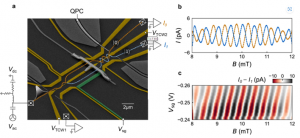 Discover the latest scientific publication of EQUBITFLY in Nature Communications by S. Ouacel et al.
Discover the latest scientific publication of EQUBITFLY in Nature Communications by S. Ouacel et al.
Electronic interferometry with ultrashort plasmonic pulses.
S. Ouacel, L. Mazzella, T. Kloss, M. Aluffi, T. Vasselon, H. Edlbauer, J. Wang, C. Geffroy, J. Shaju, M. Yamamoto, D. Pomaranski, S. Takada, N.H. Kaneko, G. Georgiou, X. Waintal, M. Urdampilleta, A. Ludwig, A.D. Wieck, H. Sellier, C. Bäuerle. Nature Communications, 16, 4632 (2025).
DOI: https://doi.org/10.1038/s41467-025-58939-4
Abstract:
Electronic flying qubits offer an interesting alternative to photonic qubits: electrons propagate slower, hence easier to control in real time, and Coulomb interaction enables direct entanglement between different qubits. Although their coherence time is limited, flying electrons in the form of picosecond plasmonic pulses could be competitive in terms of the number of achievable coherent operations. The key challenge in achieving this critical milestone is the development of a new technology capable of injecting ‘on-demand’ single-electron wavepackets into quantum devices, with temporal durations comparable to or shorter than the device dimensions. Here, we take a significant step towards achieving this regime in a quantum nanoelectronic system by injecting ultrashort single-electron plasmonic pulses into a 14-micrometer-long Mach-Zehnder interferometer. Our results establish that quantum coherence is robust under the on-demand injection of ultrashort plasmonic pulses, as evidenced by the observation of coherent oscillations in the single-electron regime. Building on this, our results demonstrate the existence of a “non-adiabatic” regime that is prominent at high frequencies. This result highlights the potential of flying qubits as a promising alternative to localised qubit architectures, offering advantages such as a reduced hardware footprint, enhanced connectivity, and scalability for quantum information processing.


